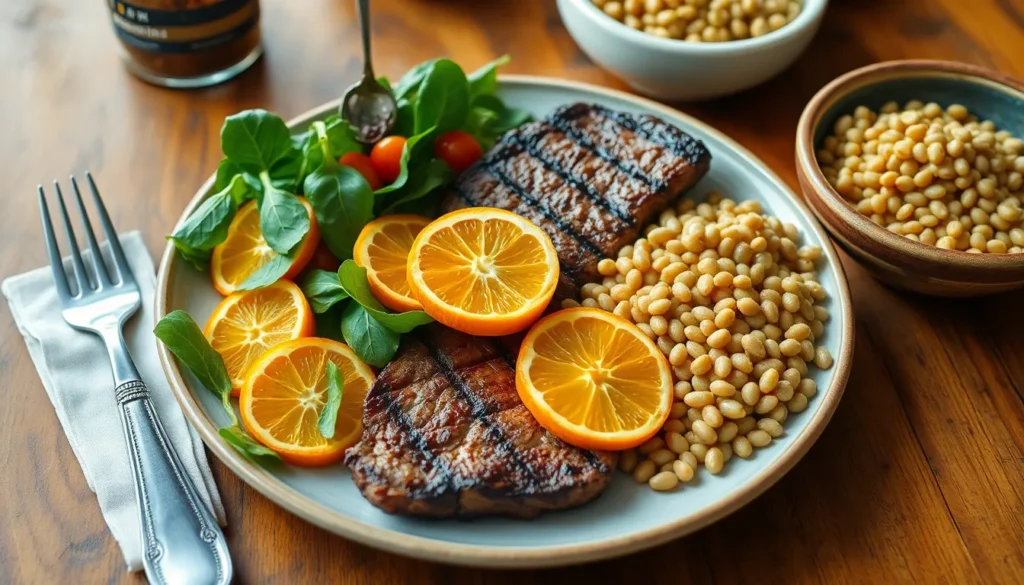Table of Contents
ToggleFeeling a bit sluggish? It might be time to give your meals a serious iron boost. Iron isn’t just a metal; it’s the superhero of nutrients, swooping in to save the day by fighting fatigue and keeping energy levels high. Whether you’re a gym enthusiast or just trying to keep up with daily life, iron-rich meals can transform your plate from drab to fab.
Understanding Iron Rich Meals
Iron rich meals play a crucial role in maintaining optimal health. Consuming a diet high in iron can effectively combat fatigue and boost energy levels. Various food sources provide heme and non-heme iron, with heme iron found in animal products and non-heme in plant-based options.
Meat options like beef, lamb, and poultry are excellent sources of heme iron. These meals contribute significantly to dietary iron intake. Dark leafy greens such as spinach and kale offer plentiful non-heme iron, while legumes like lentils and chickpeas serve as vital sources in vegetarian diets.
Many fortified cereals also deliver iron, making breakfast a key opportunity for iron intake. Pairing iron-rich foods with vitamin C sources can enhance absorption. For instance, enjoying a spinach salad with citrus dressing increases the body’s ability to utilize iron efficiently.
Iron obtained from food sources promotes the production of hemoglobin, which transports oxygen throughout the body. A diverse array of iron rich meals helps meet daily nutrient requirements. Planning meals that incorporate a balance of both heme and non-heme iron ensures robust energy levels and optimal vitality.
Individuals aiming to increase their iron intake should consider snacks as well. Nuts and seeds deliver a convenient source of non-heme iron. Smoothies containing spinach or fortified nut milk can serve as delicious options to boost iron levels. Focusing on these meal and snack options will enhance overall energy and health.
Importance of Iron in Our Diet

Iron serves as a vital nutrient, essential for maintaining overall health and energy levels. Integrating iron-rich meals into daily consumption boosts vitality significantly.
Health Benefits of Iron
Iron supports multiple health functions. It plays a key role in hemoglobin production, crucial for oxygen transportation in the blood. Energy levels improve when iron intake is adequate, reducing fatigue. Enhanced cognitive function occurs when iron is present, aiding in concentration and focus. Immune system function benefits as well, as iron contributes to the development of immune cells. Consuming iron-rich foods can promote healthier skin, hair, and nails through improved nutrient delivery.
Consequences of Iron Deficiency
Iron deficiency leads to several health issues. Fatigue and weakness often present as common symptoms. In some cases, individuals may experience shortness of breath during physical activity due to insufficient oxygen supply. Cognitive impairments, such as decreased attention span and coordination issues, can arise. Moreover, iron deficiency increases the risk of anemia, a condition characterized by a reduced number of red blood cells. Pregnant women may encounter complications due to low iron levels, impacting both maternal and fetal health. Consistent monitoring of iron intake helps prevent these adverse effects.
Top Sources of Iron Rich Meals
Iron-rich meals provide essential nutrients for energy and health. Incorporating a variety of these sources into daily meals enhances overall vitality.
Animal-Based Iron Sources
Beef stands out as a top source of heme iron. Lamb and pork also contribute significantly to iron intake. Poultry, such as chicken and turkey, contains substantial amounts of iron. Fish, including tuna and salmon, adds diversity to iron-rich options. Organ meats, especially liver, offer some of the highest concentrations of iron. Incorporating these foods into the diet supports robust hemoglobin production and boosts energy levels.
Plant-Based Iron Sources
Legumes like lentils and chickpeas serve as excellent non-heme iron sources. Dark leafy greens, particularly spinach and kale, provide substantial amounts of iron while offering additional nutrients. Tofu and tempeh also contribute to plant-based iron intake. Quinoa stands out as a grain that combines iron with protein. Nuts and seeds, such as pumpkin seeds and almonds, offer versatile snack options rich in iron. Consuming these foods alongside vitamin C-rich items can enhance iron absorption, further promoting vitality.
How to Prepare Iron Rich Meals
Preparing iron-rich meals involves a few strategic methods. Emphasizing cooking techniques and selecting the right recipes can significantly enhance iron absorption and overall nutrition.
Cooking Techniques to Maximize Iron Absorption
Utilizing specific cooking methods can improve iron intake. Steaming vegetables preserves more nutrients compared to boiling. Sautéing or stir-frying helps retain vitamins while adding flavor. Incorporating vitamin C sources, like tomatoes or bell peppers, into recipes boosts non-heme iron absorption significantly. Cooking with cast iron cookware can also enrich foods with additional iron, especially when preparing acidic dishes such as chili or tomato sauce. Pairing heme and non-heme iron sources in meals ensures a balanced nutrient profile.
Meal Ideas and Recipes
Creating delicious iron-rich meals is simple and enjoyable. Start with a hearty lentil soup, using lentils, carrots, and spinach. Consider a beef stir-fry featuring strips of beef, broccoli, and bell peppers for flavor and nutrition. A quinoa salad with black beans, avocado, and lime enhances iron and provides healthy fats. Stuffed bell peppers with ground turkey, brown rice, and spices serve as a satisfying dish rich in iron. For snacking, try a trail mix made with nuts, seeds, and dried fruit to boost iron throughout the day. Each of these options ensures a flavorful way to meet daily iron needs.
Tips for Incorporating Iron into Your Diet
Incorporating iron into a daily diet involves strategic planning. Focus on combining heme and non-heme iron during meals. For instance, pair a beef stir-fry with a side of sautéed spinach. This combination aids in maximizing iron absorption.
Including vitamin C-rich foods enhances iron absorption significantly. Citrus fruits, bell peppers, and tomatoes not only add flavor but also increase bioavailability. Next, consider using cast iron cookware. Cooking in cast iron can enrich foods with additional iron, especially for acidic dishes like tomato sauce.
Planning meals around iron-rich foods is essential for maintaining energy levels. A hearty lentil soup can serve as a nutritious lunch option, packed with non-heme iron. Quinoa salads topped with nuts and seeds offer versatility and nutrition. Opting for snacks like trail mix or smoothies with spinach provides a convenient boost in iron intake.
Pay attention to portion sizes for both meat and plant-based iron sources. Eating substantial portions of lentils, beef, or leafy greens contributes to daily iron requirements. Experimenting with different recipes can keep meals exciting while ensuring ample iron consumption.
Lastly, monitor iron intake regularly to maintain optimal health. Understanding the sources of iron-rich meals empowers individuals to make informed dietary choices, preventing potential deficiencies. Adopting these practices promotes not only increased iron absorption but also overall vitality.
Incorporating iron-rich meals into one’s diet is essential for maintaining energy levels and overall health. By understanding the differences between heme and non-heme iron sources, individuals can make informed choices that support their nutritional needs.
Pairing these foods with vitamin C not only enhances iron absorption but also adds flavor and variety to meals. Regularly including a mix of both animal and plant-based iron sources can help prevent deficiencies and promote vitality.
With thoughtful meal planning and preparation techniques, anyone can enjoy delicious dishes while ensuring they meet their daily iron requirements. Prioritizing iron intake is a simple yet effective way to boost energy and support overall well-being.







